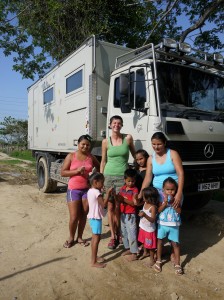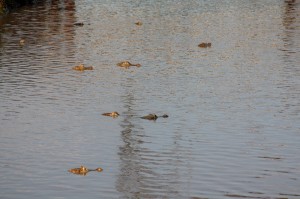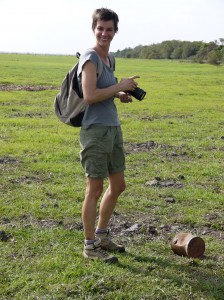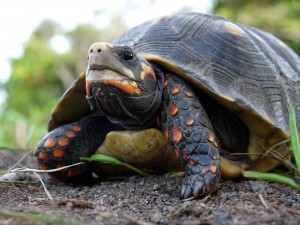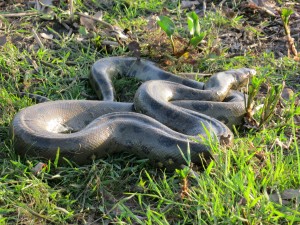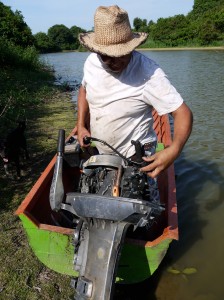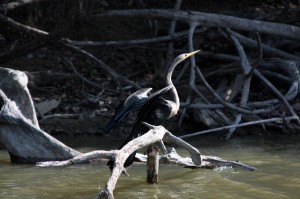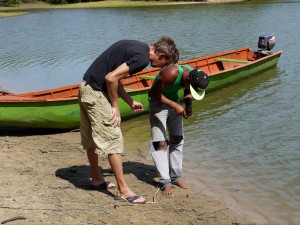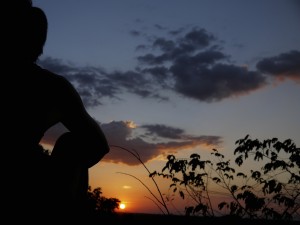Within just an hour or so we dropped from over 3500 meters to zero elevation. And we felt the air temperature is changing rapidly as we were driving on straight, flat roads on the scorching sun. Our box (the house) is well insulated and keeps the cold air inside longer. It is gradually warms up of course but usually the first day/night is cooler inside.
Los Llanos is Venezuela’s Great Plain and it takes one third of the country. It has two seasons, Dry and Wet and in these two seasons the scenery is dramatically different. Although the tens of thousands of sq meter area is parcelled up to huge private lands -ranches scattered around, sometimes well over 10 of kms away from each other, it is quite a unique and spectacular place. The local cowboys herd their cattle on to the rested grassland where the domesticated cows and horses hang out with the area’s natural fauna. In the dry season there are smaller lakes, ponds a few slow-running rivers where all animals gather at once.
Los Llanos is one of the premier wildlife-viewing areas on the South American continent and next to the sometimes quite unique-looking domesticated cows there are tremendous species of birds, capybara, monkeys, anteaters, big cats, fox, in and around the waters there are river dolphins, caimans, anacondas, turtles and many more.
Previously John researched options to visit and stay in Los Llanos on a farm but it seemed like that all Hatos (government owned ranches) only take tourists by booking a whole 4-5 days stay, all-inclusive type of package and they are hugely expensive. When we visited the adventure agency office in Mérida, we found out from the nice guy where they take their groups, where apparently wildlife is the most abundant. We also could hold of a pretty good Venezuela map here.
So we decided, as we have our own transportation and accommodation we could just roll up and see what happens.
So the day we left the mountains we were driving all day, stopped a few times by the police (or National Guard) for checks. Once we entered Los Llanos area we saw a sign for a Hato and we thought we could try to ask if we could stay there, or get some info. As it is the low season for tourism (plus, as I gathered, they had some legal issues) they were close but had a chance to talk to the owner. He couldn’t really help us in any way. He sent us to a couple of other Hatos back on the main road. We found them but they were more of an agricultural than a tourist place, and they sent us away too.
We were pushing on, -the road was very good, good surface, flat and straight so by 4-5PM we were well in to the area we found the side road that leads in to the wildlife-viewing hub so headed down that way. The scenery was getting better and better, less human populated and more wildlife and it looked marvellous in the setting sun. As it was getting late we decided to park up as soon as we find a good hidden spot off the road. It wasn’t easy as both sides of the road was continuously fenced off.
There was not much traffic on this road and we spotted a couple on a motorbike stopping by the side of the road. We stopped next to them asked them if that would be OK if we parked up around here, off the road but behind those trees. They both said that it was peligro (dangerous). I asked why but I couldn’t work out their answer. Eventually he offered that he would lead us to his Papá and we could stay at his place for the night. We thanked him and followed them. After about 5 mins he got a puncture in his back tyre. We stopped and tried to solve the problem but it was more complicated and dark by then. They said that they live in Mantecal (a town 30-40 mins back where we came from) and they just came over to pick up a piggy and their 4 children are waiting for them back at home. John and I offered to take the wife (Maria) home while the husband (Ángel) got a lift half way with the bike on a pickup truck (the other half he rode with the puncture) Slowly we made it back to their house. They offered to park up in front of their house and stay for the night.
Their home was on a mud road with a big tree in front of it. The house was yellow and tiny. Only had the one room which was the kitchen and bedroom at the same time holding the 6 members family. Their living room was the street. Maria’s mum lived next door and had a same size house in pink.
Maria’s mum who Rosi, was looking after the 4 kids, plus had 3 kids on her own. (the oldest was 13 and the youngest 3) It was a mayhem when we arrived. The kids were jumping up and down, talking excitedly at once. Of course everyone was a bit surprised so Maria and Ángel explained the whole story. We had lollies and chocolate for the kids who went bonkers, and beer for the adults. The chairs came out and we spent hours of talking and playing with the kids and dogs on the street. Ángel and Maria was very happy when John handed two bags of wheat flour to them too (as it is difficult to get hold of flour, next to milk, at this part of Venezuela) It was one of those authentic evenings that we can never predict and all turned out well at the end. We got a bit tipsy as had no chance to have dinner -and looked like that the children had lollies and chocolate for dinner. We gone to bed at around midnight and had a reasonably good sleep.
The next morning we thanked them for the camp and headed back to the more remote area of the Llanos.
It was around 11-12AM when we arrived at Rancho Grande, another opportunity for us to ask if we could stay and take a tour. Rancho Grande is the family ranch where the company from Mérida brings their organised tours to. We thought if we find this place we could take our chances to have the same experience for a better price.
We found the owner, Ramon Gonzales a jolly middle aged cowboy, cutting grass outside the fence. As it was low season, and we didn’t book ahead we were aware that he might turns us away, but he was ready for business. We agreed in a price (BsF3000 for all; 2 night camp, 1 river tour and 1 overland tour) This was much better price as the company in Mérida asks BsF8000/ person for the same + transport and accom.
The ranch was right next to a very low lever and muddy river, absolutely rammed with caimans. We parked up next to one of the cabana with a view of the caimans.
We had a couple of hour rest before we headed out with Ramon and his 17 year old helper, called also Ramon.
Just after 3 we were all ready to go out for a few hours of wildlife watching. Ramon had a rusty old pickup and knew the best places. We jumped at the back and rattled on for about half an hour. We stopped at a place, gone over the fence and the two Ramons were in the pond up to their knees hunting for anacondas. They handed a stick to John too but John has no experience of anaconda catching so we were just watching them. (Not sure if I was entirely comfortable with the thought of harassing the poor things)
Big Ramon was very friendly and chatty. I’m not sure if our Spanish is getting better or just his warm friendly manners helped but we were actually having a very nice time.
We moved from one place to another and another seeing caimans, turtles, monkeys, anteaters, a fox, hundreds of gorgeous birds and eventually Ramon found an anaconda. It was a 2.5-3 meter, yellow belly piece. It’s hard to tell of a snake but it seemed fine staying out the water for a while then after about 8-10 mins, when he (it was a male) had enough of the show crawled back in to the safety of the water.
It just got dark when we got back from our safari tour. After a quick dinner we had an early bedtime as there will be river boat tour first thing tomorrow.
It was 8AM (super early for us) where we set off to the river. When we got to the quite wide but slow-running river (that is actually on Ramon’s property) Ramon and little Ramon fixed the engine on to the boat and we set off.
The 30-40 minutes ride really spectacular packed with water birds, caimans and turtles. We spotted river dolphins and a capybara. We stopped and docked under a tree. Big Ramon stood in the water whacking his machete until he’s got a couple of small fish to the surface. He got them out, chopped them in to a few pieces. Little Ramon got these as baits and baited a hook for piranha fishing. It was a simple fishing device; no rod, no reel just a fishing-line with a hook at the end. There’s a certain technique to piranha fishing which is through in the baited hook, feel the line and when the piranha bites you gotta drag the line with a confidant movement. Not too fast, not to slow. It takes about half of a second for the sneaky piranha to get the bait of the hook. Of course little Ramon is master of the technique and he got a few piranhas to demonstrate the moves then he handed the line to me. I had to practice for a bit but I got one at the end. It was good fun. The piranhas were let back to the river except un unlucky one that big Ramon threw up in the air, whistling to catch a few birds attention then within a split of a second a huge bird appeared and caught the fish before it would fall in to the water. It was kind of a circus number without the trained animals. As the one who managed to catch a piranha, I got to sit right on the front of the boat (like Leo and Kate in Titanic) and enjoy the ride back.
It was only midday when we got back to the farm but little Ramon offered that he would take us out around Ramon’s land, just on foot for a wildlife watch a bit later. At around 3PM he came to pick us up and we set off through the back. Ironically or unfortunately one of the dogs decided to catch us up on the prairie and trot ahead of us scaring every living thing away before we would get there. She even chased an iguana but Ramon told her off and saved the reptile from the naughty dog. He was fine and Ramon let him back to his tree of safety. We saw a few gorgeous bird and a family of capybaras.
When we got back Ramon’s wife and two kids wanted to look inside our vehicle and we got chatting and I helped the little girl (13 years old) doing her English homework. We still had some chocolate and nuts to hand out to the kids and we ended up playing domino. We gave a couple of bags of flour to Ramon’s wife too. She was so happy, she made a whole big jug of maracuja juice for us. It was a lovely evening and the kids were delightful.
The next day we said goodbye to the family and headed further more into the remote area. First we wanted to find another ranch, we read about in the book, but after a couple of hours drive we gave up and just decided to park up by the mud road we visited a couple of day ago with Ramon. It seemed to us the perfect most remote, and quietest place.
We decided to drove down that remote road as far as we could to find the perfect place for us with a view of the grazing animals on the field. Eventually we found a gate at the end of this road and in the distance we saw 3 cowboys herding cows towards us. We turned around, drove back a bit and parked up. When the cowboys caught us up, the first one said it was not OK for us to park here. We got a bit confused but couldn’t ask him why as he headed off. A few minutes later, presumably his dad arrived with the cows greeting us and saying that it is not a problem to park here. Which was great. It was still mid afternoon so we thought we will have a nice quiet time, catching up on domestic duties, read and write, take some pictures and watch the birds. Just as we were getting comfortable, watching the horses through our open panorama-hatch a big truck arrived on the field right in front of us, and the three guys started working on the fence. It was almost comical that this mud road was busiest than we realised. We haven’t seen people all day, it seems because they are all here! An hour or so later, these guys finished the fence and moved on. We were sitting on the roof top watching the sunset when a couple of cars passed us (at different times) asking who we were and offering to park up at their houses as it is peligro (dangerous) here. Again, I couldn’t gather the answer, why it is so peligro here, as it seems to me so peaceful. We said thank you and that we might to come to their.
John and I were talking about this “peligro” thing here in Venezuela -any other country we have been to, when we asked parking up at remote places we almost always got the “sí, no problem. Muy tranquilo” answers. We thought that here it might be more of a “cultural” response rather than based on reality, at least places like this. The same way as every single house has cages and bars over the windows and doors but I doubt that ever single house have been robbed before. We have no intention to park up in the middle of a dodgy place, somewhere that doesn’t feel right. Our intuitions don’t lie but sure, once someone says that some place is “dangerous”, we have to consider our circumstances at the time. As we did here too and we decided to stay. Nothing around here felt dangerous, except a water full of caimans and piranhas, so we stayed.
We had a fabulous sunset seeing lovely birds and the horses on the field heading home for the night, then had an early dinner and bedtime.
We packed up in the morning. Our next destination is about 1200-1400 kms away. It will take 2-3 days to get there. We chose the southern -less travelled route to get to Ciudad Bolívar just because it is still leading through the Llanos and we believe there will be much to see on our way. As we were leaving an older guy on a motorbike stopped next to us and said that he rode us past last night and we choose a very fine place to camp as it is very tranquil and beautiful here. I took it as an evidence of our right intuition.
Next, Ciudad Bolívar…



